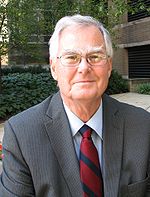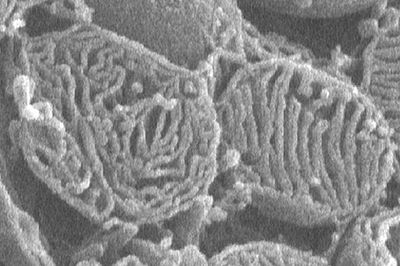Hoppel 2012 Abstract Bioblast: Difference between revisions
No edit summary |
No edit summary |
||
| Line 48: | Line 48: | ||
== Help == | == Help == | ||
* [[ | * [[Bioblast Glossary: Terms and abbreviations]] | ||
Revision as of 15:04, 16 May 2014
| Hoppel CL (2012) Mitochondrial functional testing – muscle biopsy, isolated mitochondria and others. Mitochondr Physiol Network 17.12. |
Link: MiPNet17.12 Bioblast 2012 - Open Access
Hoppel CL (2012)
Event: Bioblast 2012
Mitochondrial functional testing revolves around the key role played by ATP in energy metabolism. The mitochondrial process involves substrate translocation, metabolism with production of reducing equivalents, NADH+, FADH+, oxidation through a series of oxido-reductases (complexes) ultimately to form water, pumping protons from the matrix side to the intermembrane space, the selective impermeability of the inner membrane to protons, and the flow of protons through Complex V leading to the production of ATP from ADP, Pi, and protons. Integration of this mitochondrial function can be assessed (measured) as oxidative phosphorylation in freshly isolated mitochondria.
We isolate mitochondria from biopsies of skeletal muscle (vastus lateralis) and rarely liver from patients suspected of a mitochondrial disease. The patients have a clinical presentation and laboratory findings that suggest a mitochondrial disease. Frequently, mtDNA from whole blood has been sequenced with no known pathological mutations detected. The activity of the electron transport chain is determined in the fresh muscle and in the isolated mitochondria.
The rate of ATP production is directly determined using an amino acid and a fatty acid as substrates. The adenine nucleotide translocase and Complex V (ATPase) are measured in the isolated mitochondria. Proteomic analysis is done using Blue Native Gel Electrophoresis to quantify supercomplexes and unincorporated complexes. Quantitative phospholipid analysis is done with characterization of cardiolipin molecular species on the isolated mitochondria.
Integrated mitochondrial function is measured as oxidative phosphorylation using 19 different substrates to probe various metabolic pathways and distinct entry points of reducing equivalents into the oxidative machinery. Six different fatty acid substrates are used to assess the metabolic pathways in fatty acid oxidation. Mitochondrial membrane integrity is directly measured using NADH oxidation. The use of oxidative phosphorylation, skeletal muscle and isolated mitochondrial ETC activities provide critical information when ETC defects are accompanied with mitochondrial proliferation; i.e., a five-fold increase in mitochondrial content can move skeletal muscle ETC activity into the low normal range, whereas the defect is clear with isolated mitochondria. We believe we are identifying a new group of disorders, which have defects in oxidative phosphorylation without accompanying defects in the ETC. The amount and distribution of supercomplexes (respirosomes) is abnormal in some of these patients; alterations are still being explored in others.
Integrated mitochondrial function testing in biopsy material provides one additional approach to the diagnosis of mitochondrial diseases in challenging clinical presentations.
• Keywords: Biopsy, Diagnosis, Respirosomes
• O2k-Network Lab: US OH Cleveland Hoppel CL
Labels:
Stress:Mitochondrial Disease; Degenerative Disease and Defect"Mitochondrial Disease; Degenerative Disease and Defect" is not in the list (Cell death, Cryopreservation, Ischemia-reperfusion, Permeability transition, Oxidative stress;RONS, Temperature, Hypoxia, Mitochondrial disease) of allowed values for the "Stress" property. Organism: Human Tissue;cell: Skeletal muscle, Liver Preparation: Permeabilized tissue, Isolated Mitochondria"Isolated Mitochondria" is not in the list (Intact organism, Intact organ, Permeabilized cells, Permeabilized tissue, Homogenate, Isolated mitochondria, SMP, Chloroplasts, Enzyme, Oxidase;biochemical oxidation, ...) of allowed values for the "Preparation" property. Enzyme: Complex V; ATP Synthase"Complex V; ATP Synthase" is not in the list (Adenine nucleotide translocase, Complex I, Complex II;succinate dehydrogenase, Complex III, Complex IV;cytochrome c oxidase, Complex V;ATP synthase, Inner mt-membrane transporter, Marker enzyme, Supercomplex, TCA cycle and matrix dehydrogenases, ...) of allowed values for the "Enzyme" property., Adenine Nucleotide Translocase"Adenine Nucleotide Translocase" is not in the list (Adenine nucleotide translocase, Complex I, Complex II;succinate dehydrogenase, Complex III, Complex IV;cytochrome c oxidase, Complex V;ATP synthase, Inner mt-membrane transporter, Marker enzyme, Supercomplex, TCA cycle and matrix dehydrogenases, ...) of allowed values for the "Enzyme" property. Regulation: Substrate; Glucose; TCA Cycle"Substrate; Glucose; TCA Cycle" is not in the list (Aerobic glycolysis, ADP, ATP, ATP production, AMP, Calcium, Coupling efficiency;uncoupling, Cyt c, Flux control, Inhibitor, ...) of allowed values for the "Respiration and regulation" property., Fatty Acid"Fatty Acid" is not in the list (Aerobic glycolysis, ADP, ATP, ATP production, AMP, Calcium, Coupling efficiency;uncoupling, Cyt c, Flux control, Inhibitor, ...) of allowed values for the "Respiration and regulation" property., ATP; ADP; AMP; PCr"ATP; ADP; AMP; PCr" is not in the list (Aerobic glycolysis, ADP, ATP, ATP production, AMP, Calcium, Coupling efficiency;uncoupling, Cyt c, Flux control, Inhibitor, ...) of allowed values for the "Respiration and regulation" property. Coupling state: OXPHOS
HRR: Oxygraph-2k
Affiliations and author contributions
Charles L Hoppel
Center for Mitochondrial Diseases, Departments of Pharmacology & Medicine, Case Western Reserve School of Medicine, Cleveland, OH, USA; Email: clh5@cwru.edu
Figure 1
Rat cardiac interfibrillar mitochondria under State 4 conditions. Mostly lamelliform cristae. (Riva, Tandler, Fujioka, Hoppel)

